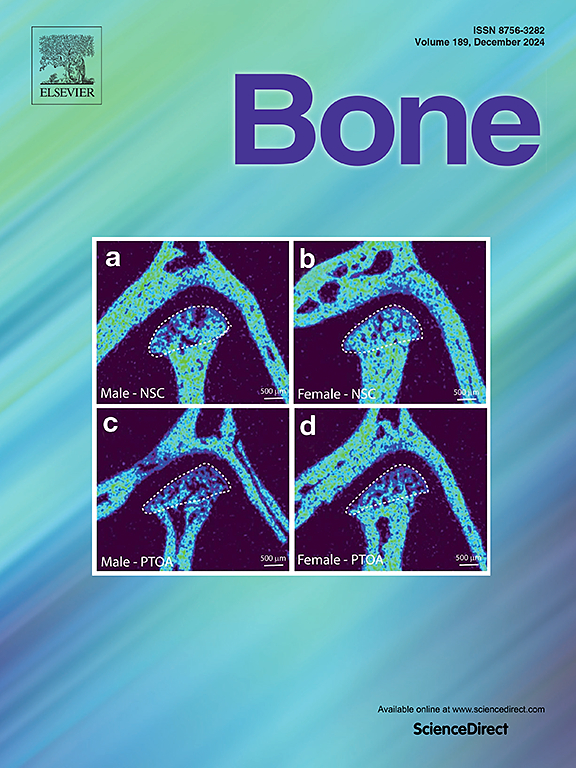Bone turnover markers and mineral density in type 1 diabetes — A cross-sectional study: DIAFALL
IF 3.5
2区 医学
Q2 ENDOCRINOLOGY & METABOLISM
引用次数: 0
Abstract
Introduction/aim
This study investigated differences in bone turnover markers (BTMs) and their associations with areal bone mineral density (aBMD) in people with type 1 diabetes (T1D) to better understand the mechanisms underlying skeletal fragility, including sex- and hormone-related variations.
Methods
A cohort of 110 Caucasian participants with T1D were matched 1: 1 with age- and sex-matched controls. aBMD at the lumbar spine, femoral neck, legs, and arms was assessed using DXA. BTMs included P1NP, osteocalcin (OC), sclerostin, CTX-1, TRAcP, IGF-1, BASP, and osteopontin (OPN). Group comparisons were conducted using t-tests, and associations between BTMs and aBMD were examined using regression and Spearman correlations. Exploratory subgroup analyses stratified women by menopausal status.
Results
Bone formation markers (P1NP, OC) were significantly lower in T1D men compared to controls (P1NP: p = 0.046; OC: p = 0.002), reflecting suppressed bone formation. IGF-1 was reduced in both sexes (p < 0.001) and correlated positively with aBMD in women (p < 0.05), but not in men. Sclerostin levels were elevated in both sexes (p = 0.002–<0.001) without correlating with aBMD. CTX-1 was reduced in T1D men (p = 0.004), while TRAcP was elevated in both sexes (p = 0.044), correlating negatively with aBMD in women. Men with T1D had significantly lower leg aBMD (p = 0.032) and reduced femoral neck bone mineral content (p = 0.041). No overall differences were observed among women; however, exploratory analyses revealed that postmenopausal women with T1D had higher TRAcP and sclerostin levels and lower femoral neck aBMD compared to premenopausal counterparts.
Conclusion
T1D was associated with significant alterations in certain BTMs and reduced aBMD in men, while skeletal effects in women appeared to be influenced by menopausal status. The weak and mostly non-significant correlations between BTMs and aBMD suggest that impaired bone quality, rather than bone mass alone, may be the primary driver of skeletal fragility in T1D. Hormonal status may further modify these effects in women.
1型糖尿病的骨转换标志物和矿物质密度-一项横断面研究:DIAFALL
本研究探讨了1型糖尿病(T1D)患者骨转换标志物(BTMs)的差异及其与面骨矿物质密度(aBMD)的关系,以更好地了解骨骼脆弱的机制,包括性别和激素相关的变化。方法对110名患有T1D的白种人患者与年龄和性别匹配的对照组进行1:1配对。使用DXA评估腰椎、股骨颈、腿和手臂的aBMD。btm包括P1NP、骨钙素(OC)、硬化蛋白、CTX-1、TRAcP、IGF-1、BASP和骨桥蛋白(OPN)。采用t检验进行组间比较,采用回归和Spearman相关检验BTMs与aBMD之间的相关性。探索性亚组分析按绝经状态对妇女进行分层。结果T1D患者骨形成标志物(P1NP、OC)较对照组明显降低(P1NP: p = 0.046;OC: p = 0.002),反映骨形成受到抑制。IGF-1在两性中均降低(p <;0.001),并与女性aBMD呈正相关(p <;0.05),但在男性中没有。两性中硬化蛋白水平升高(p = 0.002 -<0.001),与aBMD无关。CTX-1在T1D男性中降低(p = 0.004),而TRAcP在两性中升高(p = 0.044),与女性的aBMD负相关。T1D患者腿部aBMD显著降低(p = 0.032),股骨颈骨矿物质含量显著降低(p = 0.041)。在女性中没有观察到总体差异;然而,探索性分析显示,与绝经前相比,绝经后T1D妇女的TRAcP和sclerostin水平较高,股骨颈aBMD较低。结论t1d与男性某些btm的显著改变和aBMD的降低有关,而女性的骨骼效应似乎受绝经状态的影响。BTMs和aBMD之间微弱且不显著的相关性表明,骨质量受损,而不仅仅是骨量,可能是T1D患者骨骼脆弱的主要驱动因素。荷尔蒙状况可能会进一步改变女性的这些影响。
本文章由计算机程序翻译,如有差异,请以英文原文为准。
求助全文
约1分钟内获得全文
求助全文
来源期刊

Bone
医学-内分泌学与代谢
CiteScore
8.90
自引率
4.90%
发文量
264
审稿时长
30 days
期刊介绍:
BONE is an interdisciplinary forum for the rapid publication of original articles and reviews on basic, translational, and clinical aspects of bone and mineral metabolism. The Journal also encourages submissions related to interactions of bone with other organ systems, including cartilage, endocrine, muscle, fat, neural, vascular, gastrointestinal, hematopoietic, and immune systems. Particular attention is placed on the application of experimental studies to clinical practice.
 求助内容:
求助内容: 应助结果提醒方式:
应助结果提醒方式:


